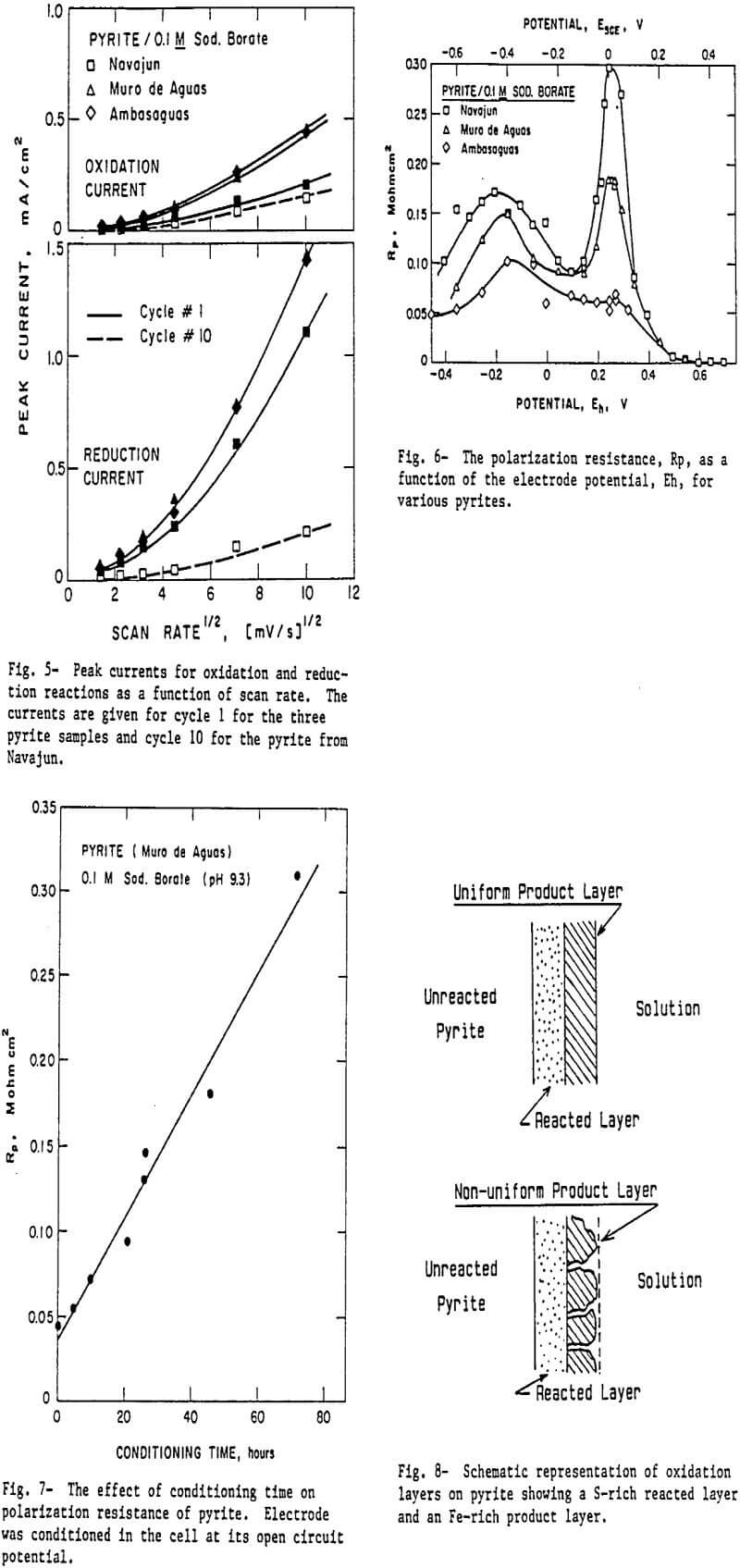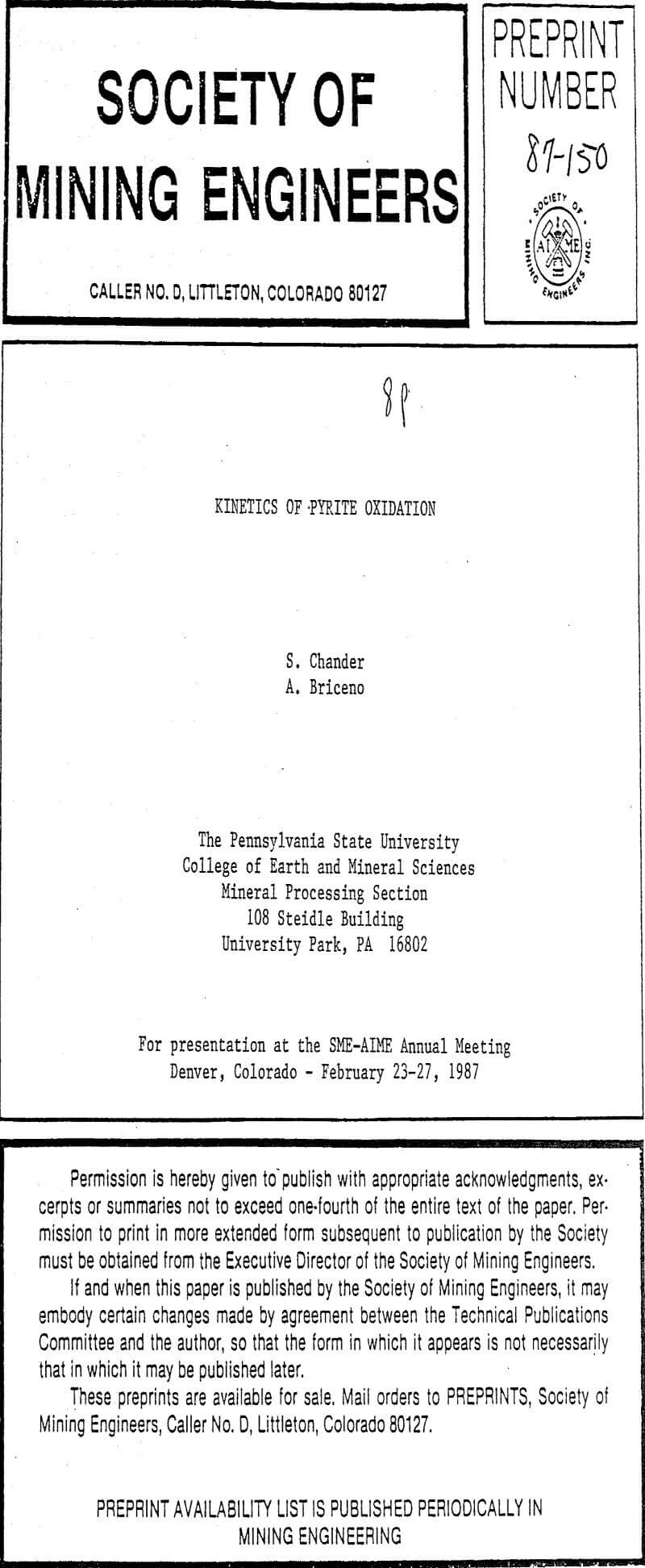Pyrite oxidation has been studied extensively, in the past, because of its importance in sulfide mineral separations by flotation, in the generation of acid in mine waters and in leaching of pyrite. The oxidation of pyrite also plays key role in supergene alteration of ore deposits, the formation of acid sulfate soils, etc. Pyrite oxidation is generally recognized as a complicated process which includes several oxidation/reduction reactions, complexation and hydrolysis reactions, and solid/solution equilibria. Both the equilibrium aspects and kinetic effects determine the oxidation behavior of pyrite under a given set of conditions. In natural environments bacteria may also participate with pyrite reactions but that aspect will not be considered in this paper. The overall reaction for pyrite oxidation may be written as:
2 FeS2 + 15/2 O2 + 4 H2O = Fe2O3 + 4 H2SO4………………………………………………….(1)
The Reaction 1 involves several changes in the oxidation states: iron from 2 to 3, sulfur from -1 to 6 and oxygen from 0 to -2. There is a general agreement that these changes do not take place in one step but involve a series of steps. For instance, pyrite oxidation occurs through formation of several intermediate ions like ferrous, ferric, thiosulfate, sulfite, dithionate and dithionite; and solid products like elemental sulfur, ferrous and ferric hydroxides, geothite, lepidocrocite, magnetite and maghemite. In addition, the nature of oxidation process depends upon other factors such as particle size, degree of stress or nature of defects in the crystal, pH, temperature and pressure.
Numerous investigations have been carried out on the oxidation of pyrite and excellent reviews are available (Hiskey and Schlitt, 1981; Nordstrom, 1982). Although a great deal of information is available regarding the rate of oxidation of pyrite and the type of solution species formed, there is a dearth of knowledge regarding the growth kinetics and properties of the product layers formed. The properties of the product layer could play an important role particularly in the flotation behavior of pyrite. The objective of this investigation was to study the properties of the product layer formed as pyrite oxidizes.
Results and Discussion
To study the kinetics of oxidation of pyrite, cyclic voltammetry and AC impedance techniques have been used in this investigation. Such an approach was necessitated due to the fact that the rates of oxidation in neutral to slightly alkaline solutions are known to be small and the standard techniques of measuring extent of oxidation are not readily applicable. The measurements are further complicated due to the formation of a variety of soluble and solid products of oxidation. As stated in the introduction section, this investigation was directed towards the study of formation and characterization of surface films as pyrite oxidizes.
For the purpose of this discussion, pyrite may be represented as
FeS2 ≡ Fe++ + S2=……………………………………………………………………(10)
Thermodynamically, the oxidation of Fe++ ions must occur at potentials greater than the oxidation of S2=, ions. The mechanism of pyrite oxidation may therefore be written as a series of steps:
1. Preferrential release of ferrous ions to form a reacted sulfur layer (S)
FeS2 → (S) + Fe++ + 2 e-……………………………………………………..(11)
2. Hydrolysis of ferrous ions to form ferrous hydroxide
Fe++ + 2 OH- + Fe(OH)2…………………………………………………(12)
3. Oxidation of ferrous to ferric ions
Fe²+ → Fe+++ + e-………………………………………………………….(13)
4. Hydrolysis of ferric ions to ferric hydroxide
Fe³+ + 3 OH- → Fe(OH)3…………………………………………………….(14)
5. Oxidation of ferrous hydroxide to ferric hydroxide
Fe(OH)2 + OH- → Fe(OH)3 + e-………………………………………..(15)
6. Aging of iron hydroxides to form more stable compounds of iron
7. Oxidation of sulfur layer to form sulfoxy anions
(S) → Sx Oy=……………………………………………………………….(16)
The formation of product layers is schematically represented in Figure 8. The unreacted pyrite is proposed to be separated from the product layer by a S-rich reacted layer. The product layer consists of iron compounds (hydroxides, oxides, etc.). This layer may be uniform or non-uniform, porous or non-porous, adherent or non-adherent, depending upon conditions of oxidation. The nature of the product layer is likely to play a key role in the flotation and depressant behavior of pyrite. The characteristics of such layers are being presently investigated in our laboratories.
The results of cyclic voltammetry and AC impedance measurements show that the oxidation behavior of pyrite depends also upon its source. Certain pyrites are passivated under moderately oxidizing conditions and oxidize slowly whereas other pyrites do not passivate under similar conditions and oxidize more readily.
Pyrite is readily covered by iron hydroxides. Both ferrous and ferric hydroxides undergo irreversible reactions involving one electron. On aging ferric hydroxide transforms into more stable species which is then reduced to ferrous hydroxide at potentials more reducing than the reduction potential of ferric hydroxide. The growth of surface films near corrosion potential of pyrite follows linear kinetics which is attributed to a chemical (or an electrochemical) reaction as the rate determining step.


